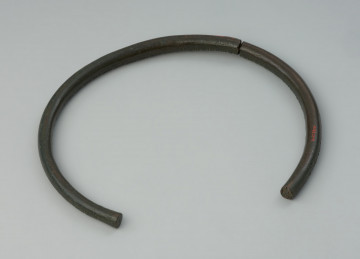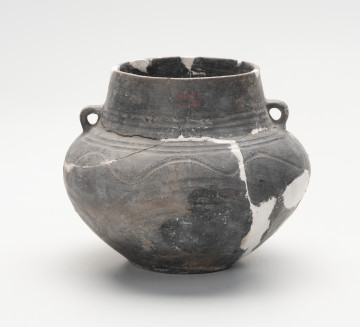
A rim necklace
around 600 p.n.e. — 400 p.n.e.
National Museum in Szczecin
Part of the collection: Bronze Age
The original greave has been made from thick brown sheet metal. It is hollow inside. Obtaining this effect required casting on a clay core, which could be easily removed. The relic is decorated with groups of bands in the form of transverse ribbing. Such an imposing, heavy hoop was certainly not an everyday ornament for the body. The fact that it was hidden in a hoard trove of ornaments and bronze tools, which was discovered in the middle of the 19th century, proves the special - prestigious, material, spiritual - significance of this object. In 1933, Mr von Grünberg donated the find to the collection of the museum in Szczecin. He claimed that the bronzes had been in his family for many decades. In 1934, an article was published, which first wrote about this find ...rarity of forms, good state of preservation and high-quality craftsmanship, allows the discovery from Wąsosz to be counted among the most unusual Pomeranian hoards.... At the end of World War II, the deposit was transported from Szczecin deep into Germany. It returned to Szczecin collections only in 2009 under the Polish-German exchange of old archaeological collections. The bronzes from Wąsosz belong to a small group of about 50 hoards from the Pomeranian area, which illustrate the level of metallurgy in the Pomeranian culture in the Hallstatt period D (years approx. 600/550-400/450 BC). That was the time when a significant development of foundry works took place. Its high level can be seen mainly in the production of difficult to make breastplates, consisting of several or more forged hoops fastened with cast openwork buckles, and other impressive ornaments: empty armlets, ornamented kidney-shaped bracelets, or richly decorated necklaces. Bronze was also used to create small objects such as pins, earrings, pendants, studs, or pincers.
Dorota Kozłowska
Author / creator
Dimensions
the entire object: height: 2 cm
Object type
anklet, bangle (hoop), body adornment
Technique
clay core casting
Material
bronze
Origin / acquisition method
legal transfer
Creation time / dating
Creation / finding place
Owner
National Museum in Szczecin
Identification number
Location / status

around 600 p.n.e. — 400 p.n.e.
National Museum in Szczecin

around 750 p.n.e. — 550 p.n.e.
National Museum in Szczecin

circa 1100 p.n.e. — 750 p.n.e.
National Museum in Szczecin
DISCOVER this TOPIC
National Museum in Szczecin
DISCOVER this PATH
Educational path